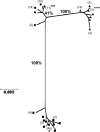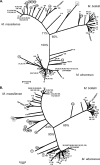Multilocus sequence analysis and rpoB sequencing of Mycobacterium abscessus (sensu lato) strains
- PMID: 21106786
- PMCID: PMC3043527
- DOI: 10.1128/JCM.01274-10
Multilocus sequence analysis and rpoB sequencing of Mycobacterium abscessus (sensu lato) strains
Abstract
Mycobacterium abscessus, Mycobacterium bolletii, and Mycobacterium massiliense (Mycobacterium abscessus sensu lato) are closely related species that currently are identified by the sequencing of the rpoB gene. However, recent studies show that rpoB sequencing alone is insufficient to discriminate between these species, and some authors have questioned their current taxonomic classification. We studied here a large collection of M. abscessus (sensu lato) strains by partial rpoB sequencing (752 bp) and multilocus sequence analysis (MLSA). The final MLSA scheme developed was based on the partial sequences of eight housekeeping genes: argH, cya, glpK, gnd, murC, pgm, pta, and purH. The strains studied included the three type strains (M. abscessus CIP 104536(T), M. massiliense CIP 108297(T), and M. bolletii CIP 108541(T)) and 120 isolates recovered between 1997 and 2007 in France, Germany, Switzerland, and Brazil. The rpoB phylogenetic tree confirmed the existence of three main clusters, each comprising the type strain of one species. However, divergence values between the M. massiliense and M. bolletii clusters all were below 3% and between the M. abscessus and M. massiliense clusters were from 2.66 to 3.59%. The tree produced using the concatenated MLSA gene sequences (4,071 bp) also showed three main clusters, each comprising the type strain of one species. The M. abscessus cluster had a bootstrap value of 100% and was mostly compact. Bootstrap values for the M. massiliense and M. bolletii branches were much lower (71 and 61%, respectively), with the M. massiliense cluster having a fuzzy aspect. Mean (range) divergence values were 2.17% (1.13 to 2.58%) between the M. abscessus and M. massiliense clusters, 2.37% (1.5 to 2.85%) between the M. abscessus and M. bolletii clusters, and 2.28% (0.86 to 2.68%) between the M. massiliense and M. bolletii clusters. Adding the rpoB sequence to the MLSA-concatenated sequence (total sequence, 4,823 bp) had little effect on the clustering of strains. We found 10/120 (8.3%) isolates for which the concatenated MLSA gene sequence and rpoB sequence were discordant (e.g., M. massiliense MLSA sequence and M. abscessus rpoB sequence), suggesting the intergroup lateral transfers of rpoB. In conclusion, our study strongly supports the recent proposal that M. abscessus, M. massiliense, and M. bolletii should constitute a single species. Our findings also indicate that there has been a horizontal transfer of rpoB sequences between these subgroups, precluding the use of rpoB sequencing alone for the accurate identification of the two proposed M. abscessus subspecies.
Figures



Similar articles
-
Phylogenetic analysis of Mycobacterium massiliense strains having recombinant rpoB gene laterally transferred from Mycobacterium abscessus.PLoS One. 2017 Jun 12;12(6):e0179237. doi: 10.1371/journal.pone.0179237. eCollection 2017. PLoS One. 2017. PMID: 28604829 Free PMC article.
-
Multilocus sequence typing scheme for the Mycobacterium abscessus complex.Res Microbiol. 2014 Feb-Mar;165(2):82-90. doi: 10.1016/j.resmic.2013.12.003. Epub 2013 Dec 31. Res Microbiol. 2014. PMID: 24384536
-
Cohort study of molecular identification and typing of Mycobacterium abscessus, Mycobacterium massiliense, and Mycobacterium bolletii.J Clin Microbiol. 2009 Jul;47(7):1985-95. doi: 10.1128/JCM.01688-08. Epub 2009 May 6. J Clin Microbiol. 2009. PMID: 19420162 Free PMC article.
-
Mycobacterium abscessus. "Pleased to meet you, hope you guess my name...".Ann Am Thorac Soc. 2015 Mar;12(3):436-9. doi: 10.1513/AnnalsATS.201501-015OI. Ann Am Thorac Soc. 2015. PMID: 25643064 Review.
-
Mycobacterium abscessus Complex-Associated Chronic Meningitis: Time to Think Beyond Tuberculosis.Neurol India. 2023 Sep-Oct;71(5):946-952. doi: 10.4103/0028-3886.388095. Neurol India. 2023. PMID: 37929432 Review.
Cited by
-
MabsBase: a Mycobacterium abscessus genome and annotation database.PLoS One. 2013 Apr 29;8(4):e62443. doi: 10.1371/journal.pone.0062443. Print 2013. PLoS One. 2013. PMID: 23658631 Free PMC article.
-
Comparative Analysis of Whole-Genome and Methylome Profiles of a Smooth and a Rough Mycobacterium abscessus Clinical Strain.G3 (Bethesda). 2020 Jan 7;10(1):13-22. doi: 10.1534/g3.119.400737. G3 (Bethesda). 2020. PMID: 31719113 Free PMC article.
-
Comparing the Utilities of Different Multilocus Sequence Typing Schemes for Identifying Outbreak Strains of Mycobacterium abscessus subsp. massiliense.J Clin Microbiol. 2019 Dec 23;58(1):e01304-19. doi: 10.1128/JCM.01304-19. Print 2019 Dec 23. J Clin Microbiol. 2019. PMID: 31619535 Free PMC article.
-
Phylogenomics of Brazilian epidemic isolates of Mycobacterium abscessus subsp. bolletii reveals relationships of global outbreak strains.Infect Genet Evol. 2013 Dec;20:292-7. doi: 10.1016/j.meegid.2013.09.012. Epub 2013 Sep 18. Infect Genet Evol. 2013. PMID: 24055961 Free PMC article.
-
PCR amplification of the erm(41) gene can be used to predict the sensitivity of Mycobacterium abscessus complex strains to clarithromycin.Exp Ther Med. 2020 Feb;19(2):945-955. doi: 10.3892/etm.2019.8289. Epub 2019 Dec 5. Exp Ther Med. 2020. PMID: 32010256 Free PMC article.
References
-
- Adekambi T., Berger P., Raoult D., Drancourt M. 2006. rpoB gene sequence-based characterization of emerging nontuberculous mycobacteria with descriptions of Mycobacterium bolletii sp. nov., Mycobacterium phocaicum sp. nov. and Mycobacterium aubagnense sp. nov. Int. J. Syst. Evol. Microbiol. 56:133–143 - PubMed
-
- Adékambi T., Drancourt M. 2004. Dissection of phylogenetic relationships among 19 rapidly growing Mycobacterium species by 16S rRNA, hsp65, sodA, recA and rpoB gene sequencing. Int. J. Syst. Evol. Microbiol. 54:2095–2105 - PubMed
Publication types
MeSH terms
Substances
Associated data
- Actions
- Actions
- Actions
- Actions
- Actions
- Actions
LinkOut - more resources
Full Text Sources
Molecular Biology Databases
Miscellaneous

